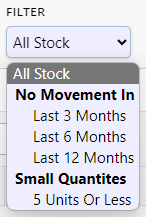We deliver. Goods and solutions.
We are a team of logistics professionals based in Auckland, New Zealand. We provide third party logistics (3PL or contract warehousing and distribution), freight forwarding and customs clearance. Our Warehouse Management System is specially developed for 3PL operations.
Logistics
Each order complies with strictly measured Key Performance Indicators (KPIs), using sophisticated systems developed and maintained in-house. The KPIs are reported live in our password-protected tracking website for any selected period.
We pick, pack and dispatch over 165,000 units of stock per week, from our modern and secure 20,000m2 facilities near Auckland airport. We are a well-established company. During the last 37 years, we developed sophisticated systems to provide 3PL (third party logistics) services.
Stock Management

You can get a full listing of your stock on hand at any time, or you can filter the listing by restricting it to certain categories or products.
These lists are particularly useful to identify slow-moving stock or ends-of-lines that are no longer available for sale on the website but are still occupying a (paid) location in the warehouse.
Our stock management charts provide some useful historical information on stock levels and stock turns, two important factors for maximising profit.
The stock history chart compares figures for stock shipped and received in the current year and those in the previous year, and changes in average stock on hand per month.
Stock Movements
For any one item of stock, we can trace all movements, in, out and adjustments. Listings in our portal for products or orders, like this example, enable an immediate download of the data to Excel.
Stock accuracy is achieved by a programme of regular cyclic stock counts following algorithms that ensure that each unit of stock has an equal probability of being counted in any given period.
This is routinely accepted by auditors as a suitable alternative to annual stock takes.
KPI Measurements
| Status | Units | Orders | Percent |
|---|---|---|---|
| As Ordered | 76,255 | 11,481 | 95.3% |
| Not Located | 3,726 | 20 | 4.7% |
| No Stock | 109 | 78 | 0.1% |
The "No Stock" line refers to orders received for items that we no longer have in stock. The "Not Located" line, on the other hand, relates to stock that is supposed to be in storage, but which we were unable to locate. This is one of our most closely monitored KPIs.
Cost Control
We provide information on the costs that we bill our clients for fulfilling their orders and storing their stock. We are neutral on the selection of couriers and make our bulk rates available to clients with no hidden mark-ups.
Our system works on data transferred from our clients' systems. We are experienced with the main accounting systems used by our clients in New Zealand and Australia. We develop the necessary software to integrate them with our warehouse management system.
We do not charge clients for our end of
the systems integration costs
— it is what we do.
Customs and Freight
We offer you a first-class global logistics service. We offer our clients tariff consultancy support, covering issues such as valuation, preferential origin, tariff classification, duty concessions and anti-dumping.
Our network of independent forwarders from around the world works to meet your needs. We have strong long-standing partnerships in China, India and Australia, as well as a reliable network of agents throughout the world. With each office locally managed and controlled, you will receive the highest level of professional service.
You can rely on our associates for expert advice. We consolidate orders from different suppliers, so you can take advantage of better container or airfreight rates. We offer you true point-to-point control on each shipment, through order tracking and regular reporting of consignments. Our comprehensive tracking system means we can keep you informed of your consignment's progress at all stages of the logistics chain.
We specialise in data transfer between ourselves, our clients, and their suppliers and clients. Our dedicated team will manage your account and ensure your consignments are cleared and delivered without unnecessary delays. We back our Customs consultancy services with many years' experience in preparing tariff classification rulings, submissions to the Customs Appeal Authority and duty concession applications. We draw on a large library of precedents from New Zealand and other legislations. For information on Incoterms, read more...
The information on this page was sourced from abcofprocurement.com

EXW – Ex Works
Software
Trackstock, our Warehouse Management System (WMS), was first developed in 1996. It provides RF capability for scans and inventory location. We currently have over 4 million units of stock on hand. We do not charge clients for our end of the systems integration costs — it is what we do.
We use custom-written in-house software for our main applications, using Microsoft SQL Server as the back-end database. The database and the web server are hosted in the cloud.
We have used IT to our competitive advantage since we started in 1986. In the early 1990’s, we pioneered the use of EDI as a means of streamlining customs clearances in New Zealand for goods shipped from Australian retailers and manufacturers.
Because our software is written in-house, changes that are required for each client can be made quickly and efficiently. This provides the client with more flexibility. Our small – and highly responsive – team of five in-house programmers is supplemented by an external contractor responsible mainly for network architecture and security.

.png)




